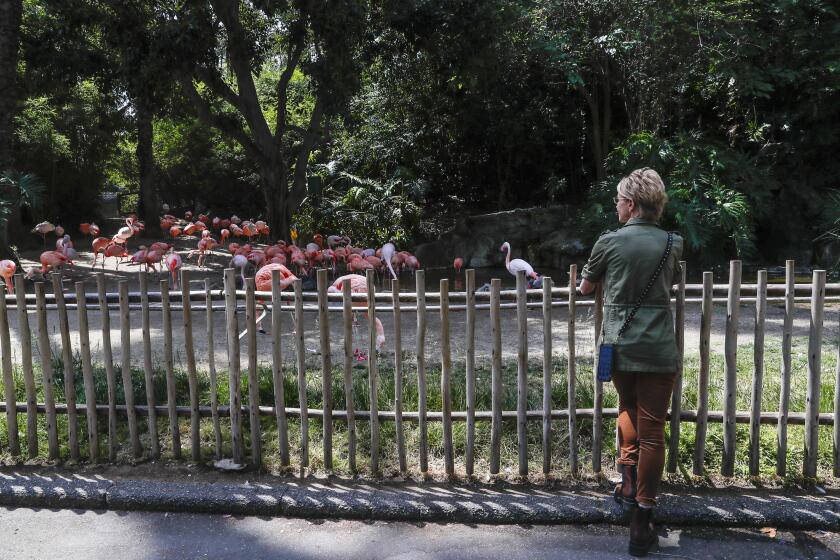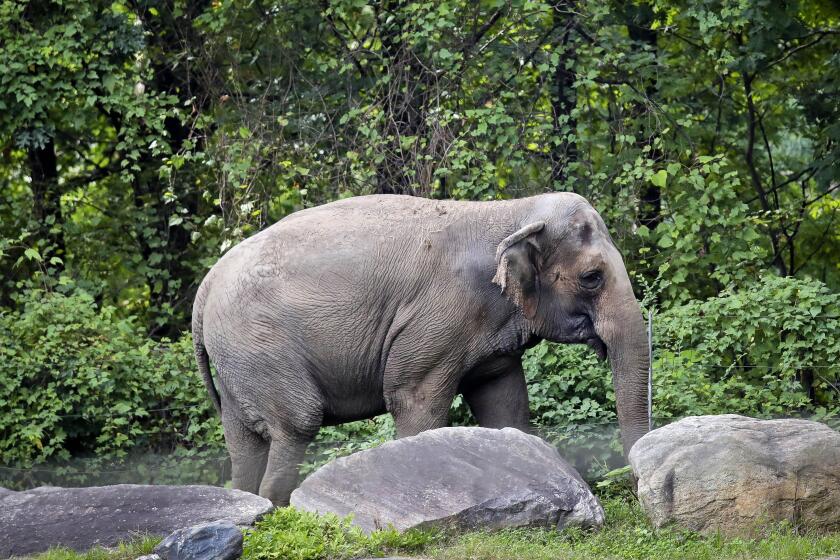Are pandas headed back to California to work their diplomatic magic?

- Share via
They are not typical diplomatic envoys. They spend their time eating, snoozing, lollygagging in the grass and rolling in the snow. But the giant pandas that have roamed a few select U.S. zoos for the last half century have captivated visitors who flocked to exhibits and lined up to see the debut of panda cubs and marvel at what seemed like plush toys come to life.
In a way that only exotic creatures can do, they enchanted Americans. So people were understandably bummed when the Chinese government ordered all remaining pandas in U.S. zoos back to China. The three at the Smithsonian’s National Zoo in D.C. flew back (via FedEx) earlier this month, with the four at Zoo Atlanta scheduled to depart next year. Did the Chinese decide to take them back as a, well, (you know), to the U.S. government at a time of deteriorating relations?
Because of the growth and further intensification of animal production, humans inflict more suffering on animals today than they did in 1975.
We don’t know exactly why the Chinese ended the panda loan but we were heartened to hear Chinese President Xi Jinping say on Wednesday after meeting with President Biden in Northern California that the Chinese “are ready to continue our cooperation with the United States on panda conservation.” He said he’d learned that the San Diego Zoo and people in California “very much look forward to welcoming pandas back.”
Yes, we do. The only giant pandas to call California home were those loaned to the San Diego Zoo, which returned its last pandas to China in 2019. “We are excited to hear of President Xi’s commitment in continuing the giant panda conservation efforts between our two countries, and his attention to the wish of Californians and the San Diego Zoo to see the return of giant pandas,” said Paul A. Baribault, president and chief executive of the San Diego Zoo Wildlife Alliance.
Zoos need to build and renovate. But the focus should be on animal welfare and conservation.
We get it that an agreement over pandas doesn’t resolve issues over spy balloons, Taiwan, fentanyl and other things. But it’s still promising and unexpected good news that the Chinese would agree to share their pandas with us again.
The program was always more than just a gift of cute rare animals. Although the first pandas did arrive in 1972 as a gift from Chinese Premier Zhou Enlai to the American people after President Nixon’s historic visit to China. During the trip, First Lady Pat Nixon told the premier how much she liked pandas.
Anyone who lived in D.C. in the ’70s and ’80s will remember the zoo’s relentless and closely chronicled efforts to get Ling Ling pregnant. (Pandas are notoriously difficult to breed.) Although the zoo was successful several times, all the cubs she bore died shortly after birth.
There’s a petition to release elephants from the Fresno Chaffee Zoo, and Ojai recently became the first U.S. city to recognize legal rights for nonhuman animals. California can lead on this issue.
The National Zoo as well as Zoo Atlanta, the San Diego Zoo and the Memphis Zoo would go on, collectively, to host more than a couple dozen pandas — including the bevy of surviving cubs born here — over the last several decades. Over the years, zoos got better at breeding and raising healthy cubs.
The panda program helped support their survival in the wild. U.S. zoos paid $1 million per year for the pandas — funds that went to China for conservation and research. Any cubs born in the U.S. zoos had to be returned at a young age. Zoo Atlanta has contributed more than $16 million for the conservation of giant pandas, the zoo says on its website. Those funds have supported research on genetic diversity and reserve management, among other projects.
The conservation efforts have helped the panda population rebound in the bamboo forests of southern China. Giant pandas were once considered endangered after their numbers dwindled to about 1,100 in the 1980s due to loss of habitat. With an estimated 1,864 pandas in the wild at last count, their status was adjusted in 2016 to “vulnerable” by the International Union for Conservation of Nature.
Reviving the panda program won’t solve the conflicts between the U.S. and China. But it is one effort toward conservation that gives another generation of Americans a chance to get to know these remarkable animals.
More to Read
A cure for the common opinion
Get thought-provoking perspectives with our weekly newsletter.
You may occasionally receive promotional content from the Los Angeles Times.












